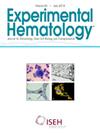Balancing hematopoietic stem cell self-renewal and differentiation activities throughout ontogeny and aging
IF 2.1
4区 医学
Q2 HEMATOLOGY
引用次数: 0
Abstract
During fetal development, lifelong hematopoietic stem cells (HSCs) emerge from hemogenic endothelium as a part of the intra-arterial hematopoietic clusters. These definitive HSCs are deemed to colonize and expand in the fetal liver, migrate to the bone marrow, and produce mature blood cells throughout life. However, emerging lines of evidence have challenged this paradigm, and alternative models have been proposed. Moreover, recent studies have revealed expansion of HSCs during aging, which seems counterintuitive to their age-dependent reduction in regenerative capacity. Here, we summarize emerging views on hematopoietic ontogeny and aging, which was the focus of the Summer 2024 International Society for Experimental Hematology (ISEH) webinar.
造血干细胞自我更新和分化活动在个体发育和衰老过程中的平衡。
在胎儿发育过程中,造血干细胞(hsc)作为动脉内造血集群的一部分从造血内皮中产生。这些确定的造血干细胞被认为在胎儿肝脏中定植和扩增,迁移到骨髓,并在一生中产生成熟的血细胞。然而,新出现的证据线挑战了这一范式,并提出了替代模型。此外,最近的研究揭示了造血干细胞在衰老过程中的扩张,这似乎与它们的年龄依赖性再生能力下降相违背。在这里,我们总结了关于造血个体发生和衰老的新观点,这是2024年夏季国际实验血液学学会(ISEH)网络研讨会的重点。摘要:在胎儿发育过程中,造血干细胞(hsc)作为动脉内造血集群的一部分从造血内皮中产生。这些确定的造血干细胞被认为在胎儿肝脏中定植和扩增,迁移到骨髓,并在一生中产生成熟的血细胞。然而,新出现的证据线挑战了这一范式,并提出了替代模型。此外,最近的研究揭示了造血干细胞在衰老过程中的扩张,这似乎与它们的年龄依赖性再生能力下降相违背。在这里,我们总结了关于造血个体发生和衰老的新观点。
本文章由计算机程序翻译,如有差异,请以英文原文为准。
求助全文
约1分钟内获得全文
求助全文
来源期刊

Experimental hematology
医学-血液学
CiteScore
5.30
自引率
0.00%
发文量
84
审稿时长
58 days
期刊介绍:
Experimental Hematology publishes new findings, methodologies, reviews and perspectives in all areas of hematology and immune cell formation on a monthly basis that may include Special Issues on particular topics of current interest. The overall goal is to report new insights into how normal blood cells are produced, how their production is normally regulated, mechanisms that contribute to hematological diseases and new approaches to their treatment. Specific topics may include relevant developmental and aging processes, stem cell biology, analyses of intrinsic and extrinsic regulatory mechanisms, in vitro behavior of primary cells, clonal tracking, molecular and omics analyses, metabolism, epigenetics, bioengineering approaches, studies in model organisms, novel clinical observations, transplantation biology and new therapeutic avenues.
 求助内容:
求助内容: 应助结果提醒方式:
应助结果提醒方式:


